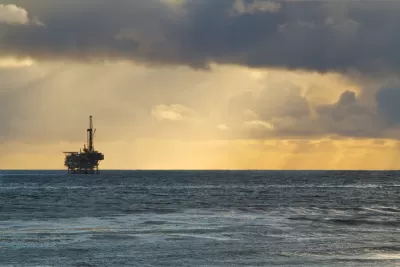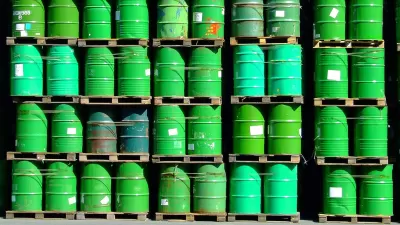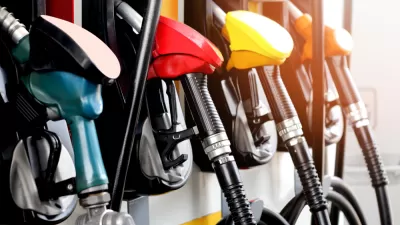Oil prices crashed Monday due to a disagreement between two of the world's largest oil producers, Saudi Arabia and Russia, amidst a slump in oil demand due to the outbreak of the coronavirus pandemic. Oil will flood the market as demand drops.

"The threat of a coronavirus-fueled oil war and ongoing panic around the outbreak brought markets to stunning lows Monday, triggering a forced halt to trading after the Standard & Poor’s 500 index sank 7 percent shortly after the opening bell," report , and "The Dow Jones industrial average cratered more than 2,000 points at the open, clawed back some losses, then drove the day’s lows to new depths."
Oil prices tumbled into the $30s, after Saudi Arabia and Russia deadlocked over production. The Saudis had been pushing for a cut in output to prop up prices, but reversed course when Russia balked and decided, instead, to flood the market with hundreds of thousands of additional barrels per day — a move analysts fear may trigger a price war.
"Markets are bracing for oil prices in the 20s," said one energy analyst in a Bloomberg News report on Monday's oil price plunge. That view was shared by Ali Khedery, a former State Department and Exxon Mobil adviser, who tweeted, "$20 oil in 2020 is coming," wrote POLITICO energy reporter, Kelsey Tamborrino, in her March 9 Morning Energy newsletter.
That means more pain for U.S. producers — and a newly aggressive Saudi Arabia to deal with in overseas markets that had just opened up to U.S. crude.
Effect on U.S. oil producers
"Now the fracking industry, which President Donald Trump sought to expand with hard-line support for increased fossil fuel production, faces potential ruin," reports Alexander C. Kaufman, who covers climate change, environmental policy and politics HuffPost.
Fracking, a ballyhooed but financially fragile sector, struggled to stay afloat with crude selling at $50 per barrel. If prices stay around $30, or even fall as low as $20, U.S. frackers simply might be unable to keep up.
“It’s a financial bloodbath,” said Clark Williams-Derry, an analyst at the Institute for Energy Economics and Financial Analysis. "With oil prices at the current level, there’s a real risk many of them will simply go bankrupt."
Kaufman elaborates on the fracking connection, noting the differences on the drilling strategy between the two leading Democratic presidential candidates, with Bernie Sanders pledging to ban it and Joe Biden who would limit or regulate it better.
Drawing an analogy with the coronavirus pandemic, Williams-Derry "likened the effect of low oil prices on U.S. frackers to an unhealthy person contracting the rapidly spreading coronavirus."
“You think of someone with a weakened immune system, and now they’re facing the coronavirus,” Williams-Derry said. “This was an industry that was already touch-and-go financially, already having severe difficulties managing debt loads. This just accelerates that problem, and brings all the other problems to the fore.”
It should be noted that fracking is a drilling strategy that applies to both oil and natural gas. It is not clear how a glut of oil will impact fracking for natural gas, which is a major issue for the swing state of Pennsylvania.
Hat tip to Dino Grandolino's Energy 202 PowerPost in The Washington Post.
Related in Planetizen:
-
Coronavirus Effects on Global Transportation System, March 9, 2020
FULL STORY: U.S. markets crater as coronavirus, oil prices trigger brief halt in trading

Study: Maui’s Plan to Convert Vacation Rentals to Long-Term Housing Could Cause Nearly $1 Billion Economic Loss
The plan would reduce visitor accommodation by 25,% resulting in 1,900 jobs lost.

North Texas Transit Leaders Tout Benefits of TOD for Growing Region
At a summit focused on transit-oriented development, policymakers discussed how North Texas’ expanded light rail system can serve as a tool for economic growth.

Why Should We Subsidize Public Transportation?
Many public transit agencies face financial stress due to rising costs, declining fare revenue, and declining subsidies. Transit advocates must provide a strong business case for increasing public transit funding.

How to Make US Trains Faster
Changes to boarding platforms and a switch to electric trains could improve U.S. passenger rail service without the added cost of high-speed rail.

Columbia’s Revitalized ‘Loop’ Is a Hub for Local Entrepreneurs
A focus on small businesses is helping a commercial corridor in Columbia, Missouri thrive.

Invasive Insect Threatens Minnesota’s Ash Forests
The Emerald Ash Borer is a rapidly spreading invasive pest threatening Minnesota’s ash trees, and homeowners are encouraged to plant diverse replacement species, avoid moving ash firewood, and monitor for signs of infestation.
Urban Design for Planners 1: Software Tools
This six-course series explores essential urban design concepts using open source software and equips planners with the tools they need to participate fully in the urban design process.
Planning for Universal Design
Learn the tools for implementing Universal Design in planning regulations.
Ascent Environmental
Borough of Carlisle
Institute for Housing and Urban Development Studies (IHS)
City of Grandview
Harvard GSD Executive Education
Toledo-Lucas County Plan Commissions
Salt Lake City
NYU Wagner Graduate School of Public Service




























